Rajasthan Board RBSE Class 10 Science Notes Chapter 8 Carbon and its Compounds
- Carbon : Atomic symbol – C ; with electronic configuration – 1s2 , 2s2 , 2p2 . Its valency is 4 (tetravalency)
- Occurrence in nature → In earth’s crust → 0.02% in the form of minerals like carbonates, coal, petroleum. In atmosphere – 0.03% of carbon dioxide (gaseous form).
- Carbon forms covalent compounds which do not conduct electricity. A covalent bond is formed by mutual sharing of electrons. This mutual sharing of electrons occurs in such a way that each of the combining atom acquires the stable electronic configuration of the nearest noble gas.
- A single bond is formed when each of the two combining atoms share 1 electron each, a double bond is formed when atoms contribute 2 electrons each and triple bond is formed when each atom contributes 3 electrons.

Allotropy:
Some elements exist in two or more different forms. This phenomenon is known as allotropy.
Allotropes of Carbon :
Carbon has 3 allotropes: diamond, graphite and fullerenes. In diamond, carbon atoms are bonded together in tetrahedral lattice arrangement. In graphite, carbon atoms are bonded together in sheets of hexagonal lattice.
In fullerenes, carbon atoms are bonded together in spherical, tubular, or ellipsoidal forms.
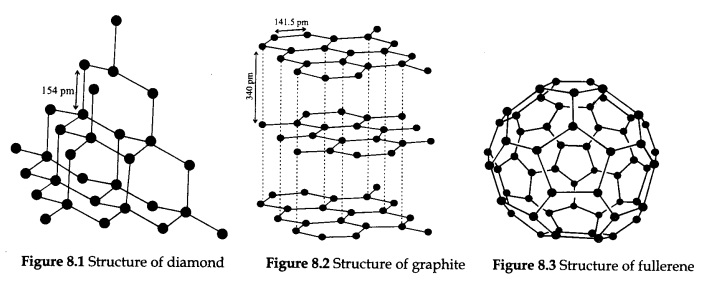
| Comparison of Diamond and Graphite | ||
| Property | Diamond | Graphite |
| Structure | Tetrahedron | Hexagonal fold in layers |
| Physical state | Colourless, transparent | Shiny opaque, black colour |
| Hardness | Extremely hard | Soft and brittle |
| Specific density | 3.51 | 2.25 |
| Electrical conductivity | Bad conductor | Good conductor |
- Used of diamond : In cutting machines, jewellery and as needle of phonogram.
- Uses of graphite : As dry lubricant, in electrodes, in pencils.
- Uses of fullerence: In purification of natural gas, as superconductor and in molecular bearings.
- Organic compounds: The tetravalency of carbon gives a possibility of large number of compounds.
- Earlier it was thought carbon compounds can be extracted from organisms only. Hence, carbon compounds are also called organic compounds.
Hydrocarbon and Its Classification
Hydrocarbon Compounds which are made up of carbon and hydrogen are called hydrocarbons
Types of Hydrocarbon:
- Acyclic Hydrocarbons: The carbon chain in these compounds is either linear or branched. These are of two types:
- Saturated Hydrocarbons: Only single bonds are present in these compounds. They are also known as alkanes. General formula of alkanes is CnH2n+2, e.g. methane, ethane, butane, etc.
- Unsaturated Hydrocarbons: A double bond or a triple bond is present in these compounds, apart from single bonds. Unsaturated hydrocarbons with double bond are called alkenes, e.g. ethene, butene, etc. Unsaturated hydrocarbons with triple bond are called alkynes, e.g. propyne, butyne, etc.
Cyclic Hydrocarbons:
The carbon chain in these compounds is in cyclic form. These are of two types:
- Alicyclic Compounds: These compounds bum without smoke, e.g. cyclohexane.
- Aromatic Compounds: These compounds bum with black smoke, e.g. benzene.
Nomenclature of Organic Compounds
There are three methods of nomenclature of organic compounds:
Trivial System:
In this system, nomenclature of a compound is based on natural source and properties of compound. Some examples are given in following table.
| Trivial System Nomenclature | ||
| Formula | Trivial Name | Natural Source |
| ch4 | Marsh gas | Found in marshes. |
| CH3OH | Wood spirit | Obtained from destructive distillation of wood. |
| CH3COOH | Acetic acid | Derived from ‘acetum’ a Latin name of vinegar. |
Derived System:
In this system, organic compounds are named as derivatives of their simple compounds. Some examples are given in following table.
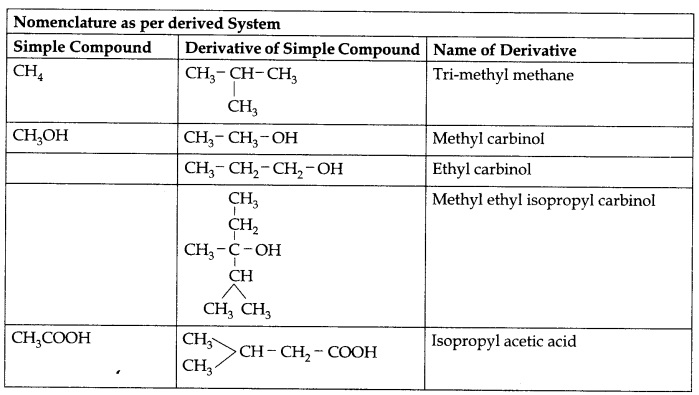
IUPAC System:
Following rules are obeyed while naming a compound:
- The prefix of compound is based on number of carbon atoms in a molecule of given compound.
- The suffix is written on the basis of type of bond in the compound.
- Name of compound is written after using appropriate prefix or suffix.
- Prefixes eth, meth, prop, but, pent, etc. are used respectively for one, two, three, four or five carbon atoms in the chain. Suffixes
ane, ene and yne are respectively used for single, double and triple bonds.
Nomenclature of Alkanes:
- The longest chain is selected. Group out of the main chain is called substituent.
- When two or more chains of same length are present then the chain with greater number of substituents is selected.
- Name of substituent is first to be written and prefixes are written in alphabetical order.
- If more than one but same substituent are present then mono, ditri, tetra, penta, etc. are written as per number of substituent.
- Two numbers are separated by comma and hyphen is used between a number and a Some examples are given below:
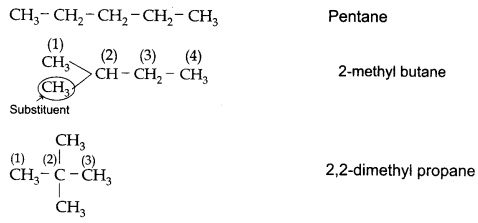
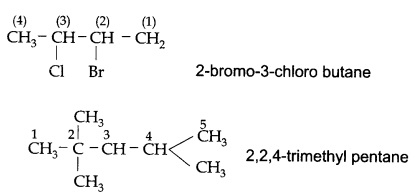
Nomenclature of Alkene:
The longest chain with double bond of carbon is selected. This is called the main chain.
Numbering of main chain is done from a direction so that the double bond gets the smallest number.
Rest of the steps is followed as per rules of nomenclature of alkane.
Some examples are given below:
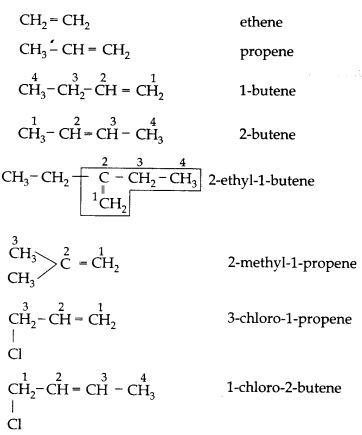
Nomenclature of Alkyne:
- The longest chain with triple bond is selected. It is called the main chain.
- Numbering of main chain is done from a direction so that the triple bond gets the smallest number.
- If more than one triple bond is present then it is shown by di, tri, tetra, etc. Some examples are given below:
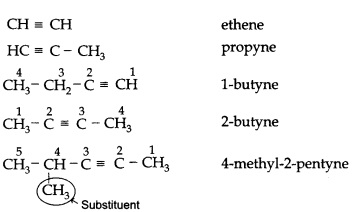
Some Important Organic Compounds
- Chlorofluorocarbons or Freon: When chlorine and fluorine make compounds with carbon, the compounds are called chlorofluorocarbons. Poly-chloro-fluoro alkane is called Freon.
- Production of Freon: When carbon tetrachloride reacts with hydrogen fluoride in presence of antimony pentachloride,
we get Freon-11.

Nomenclature of Freon:
Nomenclature of freon is on the basis of number of carbon, hydrogen and fluorine atoms in molecular formula.
Example: Freon-xyz
Here, x = number of carbon atoms -1, y = number of hydrogen atoms +1 and z = number of fluorine
atoms. Following table shows some examples.
| Nomenclature of Freon | ||||
| Molecular Formula | X | Y | z | Name of Freon |
| CFC13 | 0 | 1 | 1 | Freon-11 |
| CF2Cl2 | 0 | 1 | 2 | Freon-12 |
| C2F2Cl4 | 1 | 1 | 2 | Freon-112 |
| C2F3C13 | 1 | 1 | 3 | Freon-113 |
Uses of Freon:
As inert solvent and as coolant in refrigerator, airconditioner and cold storage.
Compressed Natural Gas (CNG):
When natural gas is compressed it is called Compressed Natural Gas (CNG). The gas present above oil layer in oil wells is called natural gas. CNG has less amount of carbon and hence is produces negligible amount of cabron monoxide or carbon dioxide on combustion. So, CNG is more environment-friendly than other petroleum products
| LPG | CNG ‘ |
| Liquefied petroleum gas is obtained after fractional distillation of crude oil. | CNG is obtained from natural gas from oil well. |
| LPG is heavier. | CNG is lighter. |
| LPG is less safe; it spreads near ground on leakage. | CNG is much safer; it spreads in air on leakage. |
| LPG is mainly used as domestic fuel. | CNG is mainly used as fuel for automobiles. |
Polymer:
When small and simple molecules join together to make a heavier molecule with long chain, it is called a polymer. The process of making polymer is called polymerization. Each unit of a polymer is called a monomer. There are two types of polymer, viz. natural polymer and synthetic polymer.
Natural Polymer:
These are obtained from nature, e.g. rubber, starch, cellulose, resin, etc.
Synthetic Polymer:
These are made in laboratory and factory, e.g. nylon, rayon, acrylic, etc.
Natural Rubber:

Natural rubber is heated with sulphur and the process is called vulcanization. Rubber obtained after vulcanization is strong, inelastic and more durable.
Nylon-66:

Uses of Nylon: For making gear, bearing in machines, tyre, cloth, fibre, ropes, toothbrush, etc.
Terylene:
is obtained by condensation of ethylene glycol and terephthalic acid. It is also called as Decron.
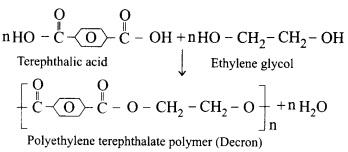
Uses of Terylene:
It is used for making cloth, sail, belt, magnetic tape, film, etc.
Rayon:
For making rayon, paper (cellulose) is dipped in sodium hydroxide solution and cleaned. After that, it is dissolved in carbon disulphide. This solution is passed through fine pores and collected in dilute sulphuric acid. The process gives fine shiny fibres of rayon.
Uses of Rayon:
Used for making cloth, threads, carpets, etc.
Polythene:
It is flexible and strong plastic used for making bags, bottles, pipe, tube, etc.

Poly Vinyl Chloride:
It is used for making pipe, shoes, slippers, bags, raincoat, toys. insulating layer, etc.

Polyacrylonitrile:
It is used for making sweater, wool-like fibre, pillow, quilt, etc.

Polystyrene:
It is used for making cups, bottle caps, refrigerator parts, wall tiles, packing materials,etc.

Synthetic Rubber: It is of two types:
- Buna-S: It is made from butadiene and styrene.
- Buna-N: It is made from butadiene and acrylonitrile.
For this, 2, 3-dimethyl-l, 3-butadiene is treated with sodium catalyst in presence of carbon dioxide to obtain a rubbe-like product. The term ‘Bu’ comes from butadiene and ‘na’ comes from Na of sodium. It is used for making oil tank, tyre-tube, medical equipments, petrol taps, shoe-soles, etc.